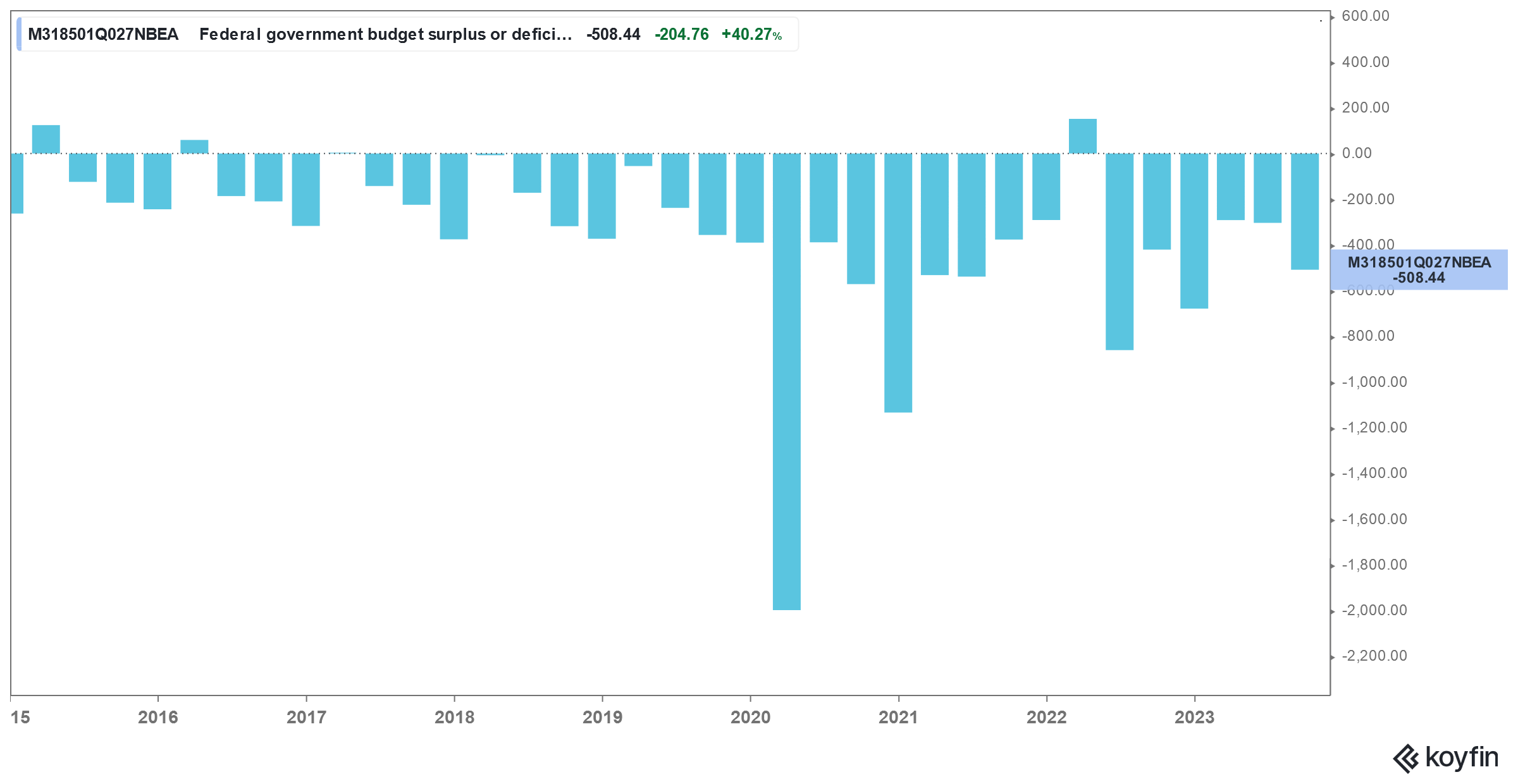US Budget Deficit Rises to Record Highs Amid Low Receipts and Higher Spending
Please note that we are not authorised to provide any investment advice. The content on this page is for information purposes only.
The US budget deficit rose to $710.9 billion in the first three months of the fiscal year 2025 which is almost 40% higher than the corresponding period in the last fiscal year and a new record for the period. The elevated deficit and a corresponding increase in US national debt has been a burning question and many economists have warned of its long-term repercussions.
In the first two months of the fiscal year, the US budget deficit had increased 64% YoY to $624 billion despite record receipts, thanks to higher spending and the timing of some outflows. The deficit actually fell 33% YoY in December to $86.7 billion but the country’s budget deficit in the three-month period was a whopping $200 billion higher than the corresponding period in fiscal year 2024.
US National Debt Has Skyrocketed
The US budget deficit has spiked ever since the country opened up its coffers to support the economy amid the COVID-19 pandemic. The deficit hit a record high of $3.13 trillion in the fiscal year 2020 but subsequently came down to $2.77 trillion in the next fiscal year. It fell to $1.38 trillion in the fiscal year 2022, but in the fiscal year 2024, the budget deficit increased to $1.8 trillion.
Thanks to the elevated deficit, the US national debt has surpassed $36 billion and is almost 123% of the GDP. For context, the ratio was under 60% at the beginning of this century and has risen significantly since then.
Higher interest rates have also added to the US debt pile.
Higher US interest rates have also added to the growing budget deficit. Interest expense soared 7% YoY to $308.4 billion in the first three months of the fiscal 2025. Financing costs topped $1 trillion last year amid higher interest rates and are expected to rise to another record high of $1.2 trillion for the current fiscal year. Interest costs are now the fourth largest expense for the US federal government after Social Security, defense, and health care.
The Fed was on a rate-hiking spree beginning in March 2022 and started with 25 basis points in March 2022 followed by 50 basis points in May. In the next four meetings of 2022, it raised rates by 75 basis points – a pace not seen in years – but toned down the hike to 50 basis points in December. The Fed raised rates four times in 2023 by 25 basis points each before it took a pause.
The US central bank cut rates by 100 basis points last year but is seen to be going slow on further cuts amid sticky inflation and uncertainty over President-elect Donald Trump’s economic policies.
The minutes of the Federal Reserve’s December meeting show that the US central bank is worried about the trade and immigration policies of President-elect Donald Trump even as it does not mention him by name. The Fed is worried that Trump’s proposed policies could fuel inflation.
Trump Wants to Bridge the Deficit Through Tariffs
Trump has incidentally touted tariffs as a tool to address the budget deficit. He has vowed to impose tariffs on goods coming from countries ranging from Canada to China which could have some inflationary impact. While in his first tenure, Trump claimed that the tariffs are borne by exporting countries, economists disagree and say that they are borne by the US consumer.
In one of his interviews, Trump said that he cannot “guarantee” that his tariffs won’t hurt Americans. Outgoing Treasury Secretary Janet Yellen also believes that tariffs would be destabilizing.
Jerome Powell Has Warned About Soaring Deficits
Last year, Fed chair Jerome Powell sounded alarm over the ever-rising US debt pile. “It’s probably time, or past time, to get back to an adult conversation among elected officials about getting the federal government back on a sustainable fiscal path,” said the Fed chair.
Powell added, “In the long run, the U.S. is on an unsustainable fiscal path. The U.S. federal government is on an unsustainable fiscal path. And that just means that the debt is growing faster than the economy. So, it is unsustainable. I don’t think that’s at all controversial. And I think we know that we have to get back on a sustainable fiscal path.”
During the “60 Minutes” interview, Powell sounded apprehensive that future generations would suffer the consequences of the current spending spree.
Jeffrey Gundlach on Rising Debt
“Bond king” Jeffrey Gundlach has also warned about the unsustainable deficits and sees Trump’s Department of Government Efficiency (DOGE) headed by Elon Musk and Vivek Ramaswamy as a good start even as he doubts it would touch “entitlements” which he sees as the real culprit.
In his note, Gundlach said, “When external pressure at last forces America’s leadership into hard choices, I believe the first move will be dollar debasement. Congress may one day impose taxes on assets—ineffective but gratifying to some.
He summed up by adding, “And there is the real possibility of a quasi-default by the Treasury, through debt restructuring beyond what today’s consensus would dare to contemplate. In the upheaval to come, few are likely to be spared.”
Meanwhile, the US is not the only major country facing a debt problem and China is also grappling with higher debt-to-GDP levels which is hampering its ability to come up with a large fiscal stimulus to revive its sagging economy. While the country has announced a flurry of monetary and fiscal policy measures and has reassured markets that it has the fiscal legroom to come up with more fiscal measures so far the actions have fallen short of market expectations.






